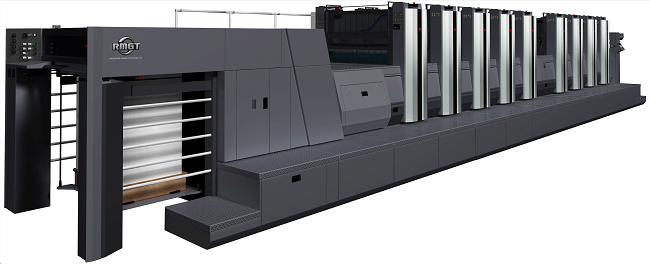All the hype about advanced digital printing equipment obscures the fact that most high-volume print jobs are still produced on offset, flexographic, and gravure printing presses. While these analog printing methods are considered mature, the newest systems incorporate technologies and automation that make them more competitive with production digital presses. So when print companies decide to replace their older analog presses, they won’t necessarily bring in new digital printing equipment.
At the PRINT 17 Show Sept. 10-14 in Chicago, you can see live demonstrations of a technologically advanced offset press: the RMGT 9 Series 8-color Perfecting Press with LED-UV and Coater. The number one 8-up press in North America, it was recognized with a PRINT 17 MUST SEE EMS’ award.

It is capable of printing to 16,200 (25.2 x 36.22 inches) sheets per hour and can be equipped with RMGT’s fully automatic plate changing, SMART Insta.Color makeready technology,and LED UV Curing for both 4/4 perfecting and LED-UV curable coatings.
At PRINT 17, plates for the press will be imaged by technology partner CRON-ECRM and the signatures will be collated, trimmed, and stitched on the Horizon FoldLiner by Standard Finishing Systems. Printed samples showing off the technology will be available at the booth throughout the show, including limited edition posters celebrating the Chicago Cubs historic 2016 World Series victory.
More than 700 RMGT presses have been installed worldwide. And during the first 8 months of 2017, RMGT has already sold twenty 9 Series perfecting presses in North America.
Azar Printing Has Purchased The Press
The press running at PRINT 17 has been purchased by Azar Printing. After they take delivery of their press at their facility in St. Louis, Missouri in late September, they will use it primarily for short to medium runs of books for business-to-business marketing and direct mail. The new press will replace two 4-up presses.
“This 8-up press fits on the same pad as our older 4-up press, and uses less electricity,” says company president Mark Azar. “Also, I can get a 16-page signature, so this press doubles capacity. This is a big deal for us.”
“We will continue to be a reliable print producer in our well-developed market space, but having the added capabilities of this state-of-the-art RMGT 9 Series will let us evolve into new markets.” Azar adds. “We are excited to see the impact this new technology will make on our company and most importantly our customers’ projects.”
In addition to doubling the sheet-size being produced, the new RMGT 9 Series press will improve turnaround time and print quality for Azar Printing’s customers. With its single-pass printing and LED-UV instant curing, the RMGT 9 Series provides a lower-cost, fast-turnaround, offset-print-quality alternative to digital presses that use toners or inkjet inks.
According to Chris Manley, president of RMGT dealer Graphco, “This marks 47 installations in North America of the 9 Series press, and we are only now picking up speed. As more printers realize the incredible benefits of this press — a 16-page signature in the smallest footprint on the market, UV LED curing, and RMGT’s well known automation the 9 Series brings profitability at much shorter run lengths than other offset presses.”
Graphic Systems North America
RMGT presses are distributed in the U.S. by Graphic Systems North America (GSNA). GSNA is a network of six factory-authorized sales and service centers that serve commercial printers, offset packaging converters and in-plant printers in the U.S. and Canada. Today the GSNA group constitutes the single largest offset press sales and service team in North America.
“It is safe to say that the RMGT 9 Series press is one of the most innovative offset presses in the world right now,” said Kian Hemmen of PFS which is one of the founders of the Graphic Systems North America distribution group for RMGT. “It can do anything a conventional offset press can do, in a smaller footprint, and with more profitability. In short, it is the offset press every modern print shop needs to stay competitive as the world — and its print requirements — continues to change.”
